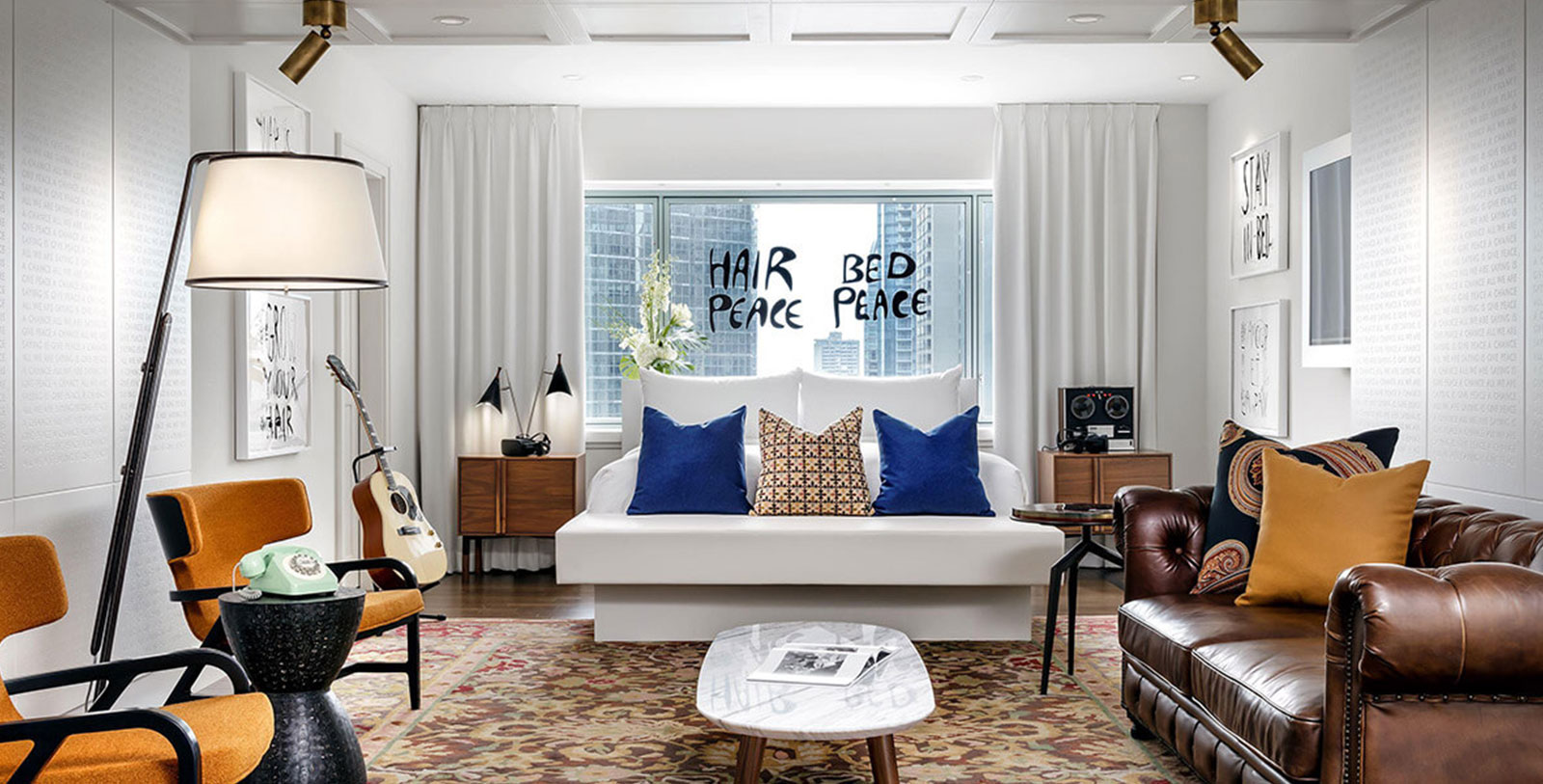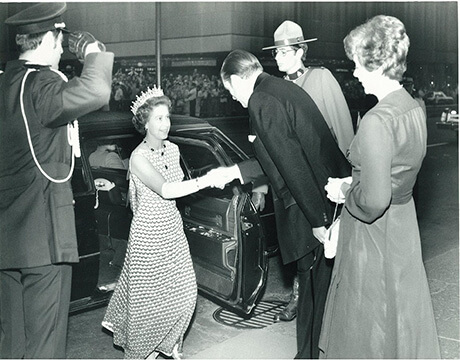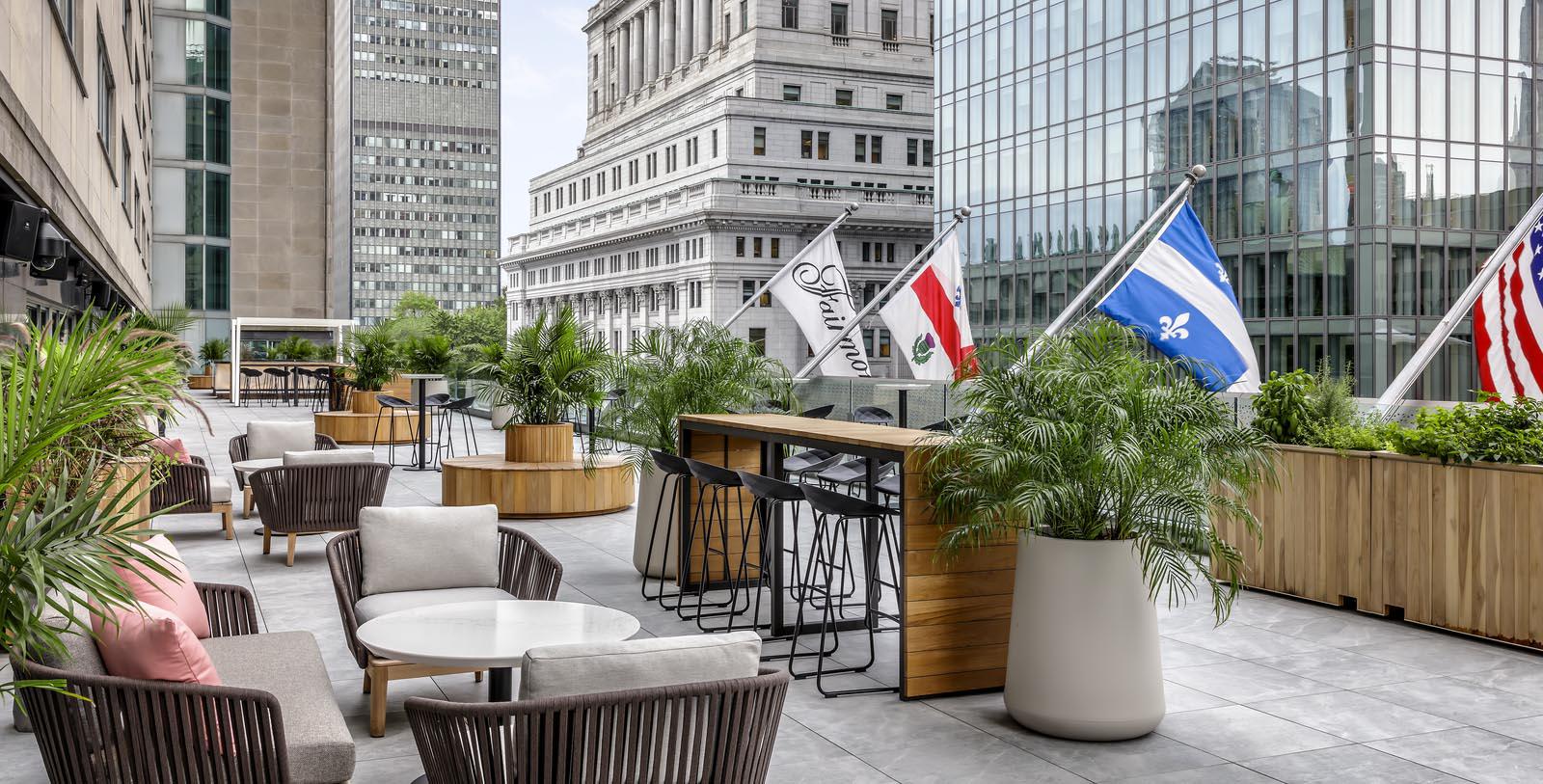Receive for Free - Discover & Explore eNewsletter monthly with advance notice of special offers, packages, and insider savings from 10% - 30% off Best Available Rates at selected hotels.
history
Discover the Fairmont Queen Elizabeth, which was the site of John Lennon and Yoko Ono’s famous “Bed-in for Peace.”
Fairmont The Queen Elizabeth, a member of Historic Hotels Worldwide since 2017, dates back to 1958.
VIEW TIMELINEA New Page of Fairmont The Queen Elizabeth’s History...
Explore the history, heritage, and continued legacy of Fairmont The Queen Elizabeth.
WATCH NOWSince opening its doors on April 15, 1958, the Fairmont The Queen Elizabeth has a special place in the heart of locals, and visitors from around the world. At the time, the sleek, 21-story convention hotel was hailed as a masterpiece of innovation. Its construction above Central Station called for the most audacious techniques available to eliminate the vibrations caused be trains passing underneath. Fairmont The Queen Elizabeth introduced new standards of hospitality to Montreal and was the keystone of a major renewal of the city’s downtown core. Designed by the architects of the Canadian National Railway Company to be the ideal hotel for international conventions, the hotel is comprised 1,216 rooms with a typically Canadian decor. It was one of the first hotels in North America with escalators, centralized air-conditioning, and direct-dial telephones stationed in each room. The hotel’s restaurants and cafés were inspired by the culinary traditions of France and Quebec, promoting the local cuisine. Gourmet guests and foodies alike found the food delightful at the hotel’s historic Beaver Club, one of the most prestigious fine dining establishments in Canada.
From its inauguration, this unique property distinguished itself by the comfort of its rooms, the efficiency of its personnel, and the high quality of its restaurants. Since 1958, Fairmont The Queen Elizabeth has been a reference in the world of luxury hospitality, and a proud partner of the city’s vibrant social community. The building has been at the center of momentous events throughout the years. In 1961, the hotel was connected to the shopping mall below Place Ville Marie by a corridor below street level, creating the first link to the in what would become the Underground City. During Expo 67, 50 of the 60 visiting heads-of-state stayed in its luxurious suites. John Lennon and Yoko Ono held their famous “Bed-in for Peace” in 1961, during which the ex-Beatle composed and recorded "Give Peace a Chance.” And several year later during 1976, the hotel was chosen as headquarters for the International Olympic Committee and welcomed dignitaries and international delegations.
Over the last few decades, prestigious personalities have made appearances at the Fairmont The Queen Elizabeth. It has been visited by Queen Elizabeth II, whom the hotel is named after, has visited no less than four times, along with other members of the British royal family. World leaders like French Presidents Charles de Gaulle and Jacques Chirac, Soviet Premier Mikhail Gorbachev, United States Presidents Jimmy Carter and George W. Bush, and South African President Nelson Mandela, as well as cultural icon—such as Joan Crawford—stayed in the hotel. Of course, the hotel is not only for celebrities, as the staff takes great pride in being part of the cherished memories and milestones of many, many guests from both Montreal and abroad. The objective of the hotel's transformation in 2017 was to make the establishment an even more important contributor within the social life of the Montreal community. Its new design reflects its commitment to continually renew itself and offer the highest standards of luxury hotels for all to enjoy. Now a member of Historic Hotels Worldwide, Fairmont The Queen Elizabeth is among the best holiday destinations in Montréal.
-
About the Location +
Montréal is an ancient cosmopolitan city, with a history that stretches back over the course of five centuries. The nucleus of the community started out as a fortress called Ville-Marie founded by Paul de Chomedey in 1642. Chomedey had hoped that his nascent outpost would function as a missionary site that would proselytize the area’s native Iroquois tribes. Shortly thereafter, King Louis XIV of France granted the settlement a town charter and established Chomedey as its governor. But aspiring frontiersmen migrated to the rustic citadel over the next 70 years, transforming it into a commercial center for the region’s booming colonial fur trade. Its proximity to the St. Lawrence River and the Great Lakes enabled French fur trappers to present their products over a wide area, even allowing for some to reach with the Mississippi River and, eventually, the Gulf of Mexico. Now known as Montréal, the city would soon become one of the most important commercial centers in all of colonial French Canada.
Montréal became a part of the British Empire in 1763, when France ceded control over most of its North American colonial possessions to the United Kingdom after the Seven Years War. An influx of English-speaking settlers then proceeded to flood the region from the Thirteen Colonies and Great Britain itself, introducing a unique—yet very intense—dualistic culture between the British and the native French Canadians. This fascinating dynamic only became more prominent when exiled loyalists from the fledgling United States fled to Canada in the wake of the American Revolution. Many of those Anglo-American settlers specifically migrated toward the shores of Lake Erie to the south, which pushed the region’s culturally French population to congregate more tightly around Montréal and Québec City. By 1791, Montréal and its surrounding environs became the epicenter for a new colony, as such—Lower Canada—while the newer British settlements around modern-day Ontario and Toronto became “Upper Canada.” A fierce rivalry over the regional fur trade ensued, with the Montréal-based North West Company pitted against the British Hudson Bay Company. Montréal, unfortunately, found itself on the losing side of the trade war, which culminated with the two companies merging in 1821.
The loss of the valuable fur trade did not prevent Montréal from growing, though, as its had also become a preeminent center for commercial transportation by the dawn of the 19th century. Like the fur traders before them, local merchants used the city’s access to the St. Lawrence River to ferry all sorts of goods into the region, from timber to produce. This economic activity only continued to expand, driven by the creation of Lachine Canal and other manmade superstructures. The city also became the central hub for the Canadian Pacific Railway several decades later, which had extended all the way to Vancouver in British Columbia by 1886. Montréal also saw the creation of Canada’s first bank—the Bank of Montreal—which provided for a sound source of capital needed to finance those projects. Much of the early economic expansion occurred due in large part to the entrepreneurial John Molson, who first introduced steamships into Montréal’s market in 1809. The railroad was later joined by a second, the Canadian National Railway, which had originally been founded in nearby Toronto. The presence of the shipping and railroad industries spurred the creation of a self-sufficient manufacturing block in downtown Montréal that became Canada’s most robust by the end of the century.
After experiencing a brief decline in economic activity during the Great Depression, Montréal emerged as one of North America’s leading commercial centers by the mid-20th century. The city’s ascent into one of the continent’s most important and culturally affluent communities led to its selection to host the 1967 International and Universal Exposition (known more commonly as “Expo 67”). Montréal was also central to Québec’s Quiet Revolution of the 1960s, in which its population contributed to the modern rise of Québécois patriotism and economic rights. That movement ultimately brought the Parti Québécois to power in the 1970s, which would continuously help to shape Montréal’s political landscape for the next three decades. Perhaps its most enduring legacy were two failed referendums in 1980 and 1995 that sought to render the Provence of Québec into its own nation-state. Nevertheless, Montréal has remained an important part of Canada’s collective cultural identity in the 21st century. Its continued contributions to commerce and art have made it one of the world’s most celebrated communities today.
-
About the Architecture +
Fairmont The Queen Elizabeth is among the best examples of International-style architecture in Montréal. International style is a modern architectural form that became prominent in Western societies at the height of the 20th century. The aesthetic first emerged during the 1920s when architects in both the United States and Europe grew tired with the ostentatious structural layouts of earlier periods. They specifically disliked the habit of combining an eclectic mixture of previous architectural forms in a manner that did little to enhance a building’s overall functionality. Those professionals instead yearned to design useful civic structures that reflected the industrializing societies within which they lived. The use of iron and steel became paramount, as did reinforced concreate and large glass paneling. Architects who supported International style also relied upon rectilinear forms that featured simple, yet dramatic, taut-plate surfaces devoid of decorative ornamentation. The interior spaces were bright and open, appearing to be visually weightless due to the wide use of cantilevers. Dozens of renowned architects from across the world soon championed International style, including the likes of Le Corbusier, Phillip Johnson, Walter Gropius, and Ludwig Mies van der Rohe. Many today consider these architects to be the pioneers of modern architecture, with some even working for the Bauhaus—a celebrated German art school in operation from 1919 to 1933.
-
Famous Historic Events +
Recording of “Give Peace a Chance” (1969): While the hotel had hosted all sorts of international luminaries over the years, its most famous tenants were ex-Beatle John Lennon and his wife, Yoko Ono. The two stayed at the Fairmont The Queen Elizabeth between May 26 and June 2, 1969, in order to hold their now-famous “Bed-Ins for Peace.” Inspired by the sit-ins of the Civil Rights Movement, the “Bed-Ins for Peace” were an experimental form of non-violent protest that denounced the Vietnam War. They had already held a prior “bed-in” at the Hilton Amsterdam in March before coming over to North America. Upon being denied entry into the United States shortly thereafter, they redirected their travel plans to Montréal. Lennon and Ono subsequently moved into Room 1742 at Fairmont The Queen Elizabeth to start the second phase of their novel demonstration. When asked by a reporter as to what the couple hoped to accomplish by staying in bed, Lennon replied: “Just give peace a chance.”
The sentence, “just give peace a chance,” quickly became a catchphrase for Lennon over the next several days, which inspired him to immortalize it in song. He asked his press officer, Derek Taylor, to find a recording engineer willing to work in Lennon and Ono’s suite. Taylor managed to employ a local studio owner named André Perry, who only brought four microphones and a four-track tape recorder for the project. The recording was subsequently attended by several prominent celebrities, including Petula Clark, Allen Ginsberg, and Dick Gregory. While Lennon provided most of the music, he was joined by Tommy Smothers of the Smothers Brothers on guitar. The song, entitled “Give Peace a Chance,” became an overnight sensation. Quickly becoming the anthem to the anti-Vietnam War movement, it peaked at #14 on the U.S. Billboard Hot 100 chart.
October Crisis (1970): In October of 1970, members of the radical Front de Libération du Québec (FLQ) kidnapped two prominent politicians: Québec Deputy Premier Pierre Laporte and British diplomat James Cross. The organization had hoped such an act would coax the Canadian government into releasing several of its members from jail. Canadian Prime Minister Pierre Trudeau quickly went into action, invoking the first—and only—peacetime use of the War Measures Act. The move sought to limit civil liberties so to rapidly arrest and detain the potential accomplices involved in the plot. While the law’s invocation had some detractors, its use was widely popular throughout Canada and particularly in Québec. The Québecoise government also moved into Fairmont The Queen Elizabeth around the same time to help Prime Minister Trudeau coordinate his response. Among its recommendations to Trudeau’s team was the use of the military as a supplement to the local law enforcement. The Trudeau administration managed to track down all of the ringleaders over the next several months, with the final three militants captured at the nearby town of Saint-Luc that December. Even though the uprising had ultimately ended peacefully, Deputy Premier Pierre Laporte still lost his life while in captivity. Nevertheless, the October Crisis galvanized opposition against the Front de Libération du Québec (FLQ) and the use of violence in general to address Québec’s possible independence.
-
Famous Historic Guests +
Joan Crawford, actress known for her roles in Mildred Place and Whatever Happened to Baby Jane?.
John Lennon, lead vocalist and rhythm guitarist for the legendary rock band, The Beatles.
Yoko Ono, political activist, and musician married to John Lennon.
Henry Kissinger, 56th U.S. Secretary of State (1973 – 1977)
Indira Gandhi, 3rd Prime Minister of India (1980 – 1984) —the only woman to ever serve in the role.
Nelson Mandela, anti-apartheid revolutionary and 1st President of South Africa (1994 – 1999)
Charles de Gaulle, World War II hero and President of France (1959 – 1969)
Jacques Chirac, President of France (1995 – 2007)
Mikhail Gorbachev, General Secretary of the Communist Party of the Soviet Union (1985 – 1991)
Princess Grace Kelly of Monaco, famous American film actress known for Mogambo and wife of Prince Rainier III.
Queen Elizabeth of the United Kingdom, The Queen Mother
Prince Phillip, Duke of Edinburgh, and consort to Queen Elizabeth II of the United Kingdom.
Queen Elizabeth II of the United Kingdom (1952 – 2022)
King Charles III of the United Kingdom (2022 – present)
Jimmy Carter, 39th President of the United States (1977 – 1981)
George W. Bush, 43rd President of the United States (2001 – 2009)
-
Film, TV and Media Connections +
Pawn Sacrifice (2014)




























